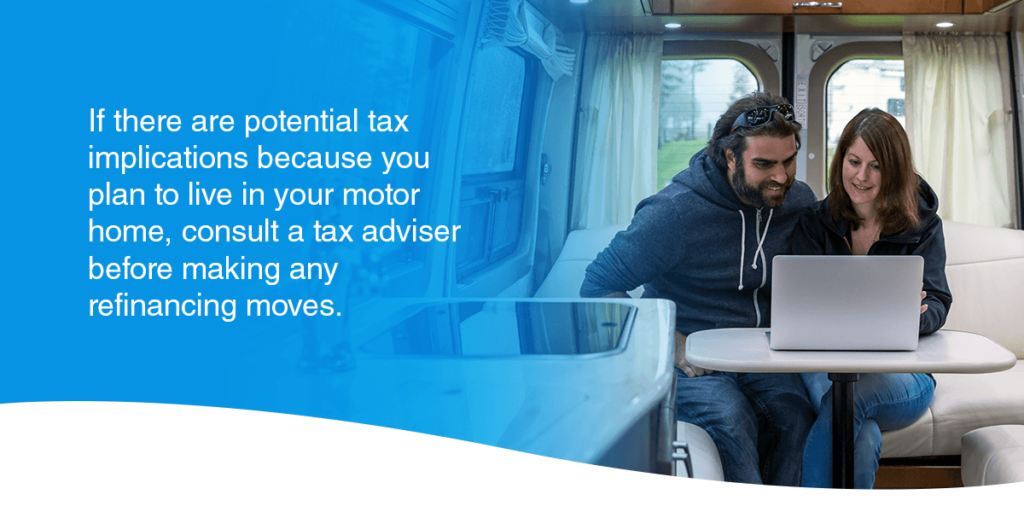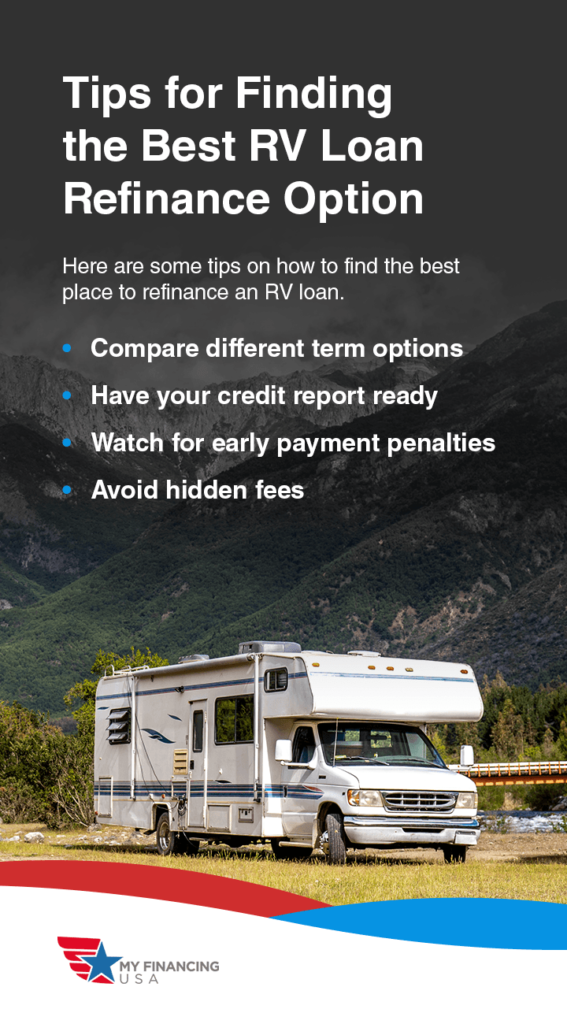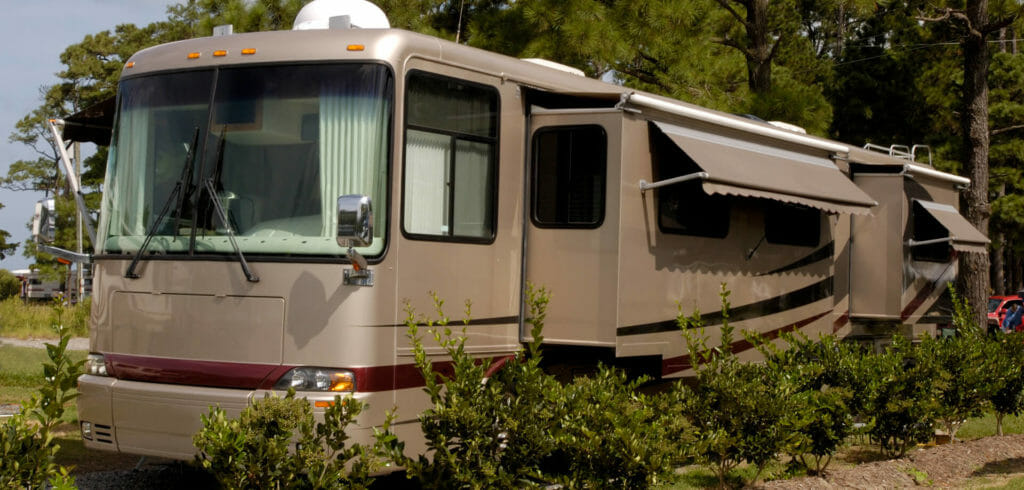Quick Navigation
- Reasons to Refinance an RV Loan
- Tips for Finding the Best RV Loan Refinance Option
- How to Refinance an RV
Our guide to refinancing your RV loan will help you determine the best RV loan refinance strategy and how to refinance an RV loan. We’ll walk you through the most crucial steps involved in refinancing and help you avoid some typical mistakes people make when refinancing their RVs.
Reasons to Refinance an RV Loan
Refinancing, or “refi,” is a lending process that allows debtors to revise and replace an existing credit agreement to make it more favorable for them. When you refinance a loan, you’re essentially taking out a new, lower-interest loan to pay off the existing one.
As someone with an RV or motor home loan, you may be wondering how you can take advantage of refinancing options to pay a lower interest rate, reduce your monthly payments or update the terms because your circumstances have changed.
Before deciding to go ahead with a refinancing agreement, considering your rationale for doing so will help you determine whether refinancing is a wise financial move now and for your future. Here are some of the primary reasons people consider refinancing loans for RVs and motor homes.
Better Interest Rates
The most common reason to refinance an RV loan is to take advantage of more recent and better interest rates. For example, let’s suppose you took out a 15-year RV loan 10 years ago at a fixed interest rate of 7.99%. Since then, lenders may have reduced their interest rates to offer more competitive financing.
Refinancing your current RV loan will allow you to pay off your existing balance at a lower interest rate. This strategy will help you save on the total amount of interest you would have otherwise paid over the remaining five years of the loan term had you maintained your original agreement. Instead of throwing this money away on interest payments, you can use it to pay down your loan quicker, provided there aren’t penalties for early repayment.
Lower Monthly Payments
In many cases, RV owners want to refinance their loans to obtain a lower monthly payment. This situation often happens when families take on new or unexpected expenses or have a reduced household income, and they need room in their budget to ensure they meet all their financial responsibilities.
When refinancing an RV loan to help reduce your monthly payments, you’re effectively taking on a new loan with a longer term to lessen your monthly burden by stretching out the principal over more time. The downside to this approach is that you’ll pay more in interest, which gets accrued over an extended period. The upshot is that you’ll have a much more manageable monthly payment from here on.
Changing RV Use

Another reason to consider refinancing your RV loan is that its principal use has changed. Perhaps when you first bought your RV, you had a more generous household income, and you used the RV primarily for recreational purposes. In this case, you may have financed the loan over a shorter period, with higher monthly payments toward the principal. Since then, you’ve had a change in circumstances, and you’ve decided, like many people, to permanently embrace an on-the-road lifestyle.
Since your RV has now become your primary residence, you might consider refinancing your loan to extend the term. By negotiating a longer loan term, you can effectively convert your RV loan into a mortgage, whereby you’re now paying toward a long-term home. This tactic also helps free up funds you can use elsewhere during this transitional time.
Improved Credit Score
If you’ve been working diligently to improve your credit score — perhaps by increasing your household income, paying down credit card debt or paying off student loans — refinancing your RV loan may be a wise move. Even developing better credit habits over the years, such as paying your bills on time and never missing payments, can dramatically improve your credit score enough to warrant refinancing.
When you have a higher credit score, a refi lender might work with you to obtain a more favorable loan agreement because you’re a lower-risk debtor. In this case, you’ll likely secure a lower interest rate than you originally had when your credit score was worse. Now, you can save on monthly interest payments, helping you free up cash for other obligations or pay off your refinanced RV loan sooner.
Learn About Boat Loans with Good Credit
How to Refinance an RV
Determine the New Loan Amount
The first thing to do when starting the refinancing process is to find out how much new credit you need. Contact your existing RV lender to find out how much you still owe on your RV loan. This amount will roughly determine the amount you'll seek from your new lender or loan.
At this point, you will also need to tell your lender about your intentions to seek refinancing. They may be able to help you refinance or warn you of any reasons refinancing right now isn’t a good idea. If your original credit agreement stipulates penalties for early repayment, you’ll also want to learn what those are and how to pay them.
Compare Refinancing Lenders
Your current lender will probably try to work with you to figure out an excellent refinancing deal, since they don’t want to lose you as a customer. However, you owe it to yourself to weigh all your options. Start shopping around for new lenders. Look for ones who specialize in RV, motor home, boat and utility vehicle lending. These lenders often work with RV owners to refinance. They can usually negotiate much better interest rates than traditional banks and credit unions, due to their borrowing power in a niche market.
When comparing refinancing lenders, consider the following:
- What interest rate are they willing to offer?
- How long is their average term length?
- Are there any tax credits or home equity loans available if you live at least part-time in your RV?
If there are potential tax implications because you plan to live in your motor home, consult a tax adviser before making any refinancing moves.

Have Your RV or Motor Home Appraised
Before refinancing your RV loan, it’s crucial to have your asset appraised — particularly when you’re refinancing to lower your monthly payments and extend your loan term. Many people who extend their loan term end up with negative equity on their asset, also known as being in an upside-down loan. This phenomenon happens when the remainder owed on the loan exceeds the RV's actual market value.
Because RVs are depreciating assets, their value drops each year. If your RV’s depreciation rate exceeds the rate at which you’re making payments, it can put you at risk financially. Should life’s circumstances change, and you need to sell your RV and pay off the loan, it would cost you more to do so because you’d also owe whatever loan balance the sale couldn’t cover.
The market standard for RV values is the NADA Guide. You can find your RV value using the NADA Guide online at www.nadaguides.com/rvs. Your lender will most likely request a copy of the NADA report on your RV during the refinancing process.
Fill out a Loan Application
Once you’ve selected the lender you want to go with for your refinancing, ask to obtain a loan application. These are usually online, but you may also be able to request a paper copy or print one out. When you first receive the loan application, read the terms and conditions thoroughly before filling out the application. Make sure you have your loan officer’s contact information and reach out to them about any parts of the agreement you don’t understand or aren’t comfortable with. You can find My Financing USA's refinance loan application at www.myfinancingusa.com/rv-loans/apply.
Once you’ve clarified all the loan conditions, begin filling out the application with the required information first. If you need to contact your bank, your employer, the original lender or another party to complete the required sections, you should do so right away.
Submit your loan application according to the lender’s instructions. Remember that the lender will need to verify your credit history to process your application, which may briefly impact your credit score depending on their process. Only apply once you’re sure about it.
Pay off the Previous Loan
Once the financing organization has approved your application, the next step is to pay off the original RV loan. When you have the funds, contact the original lender and arrange a final payment to finalize the loan and close out the account. At My Financing USA, we work directly with your lender to complete this for you.
To begin making your new payments on time, change any calendar reminders you have to match the new loan schedule. If you pay your bills using automatic bank withdrawals, be sure to set up a new account and automatic payment setting, so you never miss a payment.
Update the Title
The final step to refinancing your RV loan is to change its title. In most cases, the lender will take care of this process by releasing the old lien against the title and adding the new one.
If the new lender doesn’t update the title or you’re unsure about its status, you can contact your state’s motor vehicle department to check. They can also help you change the title if you confirm it hasn't switched over yet. My Financing USA works directly with your local or state title offices to complete the title change for you.
Learn About RV & Motorhome Refinancing
Tips for Finding the Best RV Loan Refinance Option

The most challenging part of refinancing your RV loan is choosing the best company to refinance an RV loan. There are hundreds of options to choose from. From banks and credit unions to dealerships and brokers, refinancing your RV loan can happen in many ways.
When comparing refinancing options, it’s essential to know what to look for, what makes a good lender and how to pick the best deal. Here are some tips on how to find the best place to refinance an RV loan.
- Compare different term options: As you know from your original loan agreement, RV loan terms typically range between 10 and 15 years. When looking for your new lender, you’ll want to compare different loan terms and calculate your total costs based on various lenders' interest rates. In general, you’ll want to find the one that proposes the lowest monthly rate over the shortest time.
- Have your credit report ready: When you shop around for the best company to refinance your RV loan, have your credit report ready, and ensure you understand your credit score. By knowing what makes you an attractive borrower to lenders, you can negotiate better rates. If you need to, spend a couple of months boosting your credit rating before approaching lenders for refinancing to put yourself in the best possible position to secure a deal.
- Watch for early payment penalties: Early payment or prepayment penalties are fees lenders charge borrowers for paying more than the additional payments allowed toward the loan. This practice is more common with mortgages and car loans, but they may still exist for RV refinancing loans. Be aware of this possibility and try to choose a lender that doesn’t charge this penalty.




